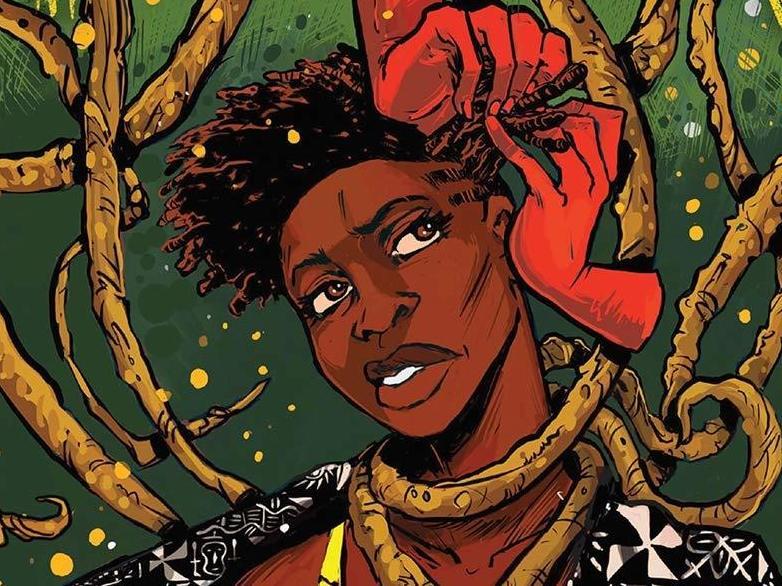Section Branding
Header Content
To Adapt 'After The Rain,' Artists Cross All Kinds Of Boundaries
Primary Content
As the market for graphic novels has taken off lately, so have graphic adaptations. That's no wonder — they let publishers simultaneously recycle existing content and snare an all-ages audience. Fortunately, the profit motive can sometimes manage to coexist with good art — and even a new kind of art criticism. Peter Kuper's Heart of Darkness, P. Craig Russell and Scott Hampton's American Gods, Odyr's Animal Farm and Miles Hyman's The Lottery are all far more than just illustrated versions of well-loved stories. Deploying a formidable arsenal of cartooning techniques, these creators comment on, interpret and unsettle familiar narratives — all without writing a word.
It's not surprising that John Jennings should achieve a comparable feat with After the Rain, his and David Brame's interpretation of a short story by Nnedi Okorafor. Besides teaching Media and Cultural Studies at the University of California at Riverside and writing extensively on cultural representations of race, Jennings drew two recent graphic adaptations of works by the great sci-fi author Octavia Butler. Like 2018's Kindred and 2020's Parable of the Sower, After the Rain is far more than a well-rendered tribute to a trailblazing black female writer. In this case, it's also a kind of visual incarnation of the story's theme.
Okorafor's story is about crossing boundaries — some tangible, others emotional or mythic. Chioma, the 39-year-old protagonist, navigates several such divides in the course of the book. Nigerian American (like her creator), she's made acutely aware of her in-between status when she goes on a two-week visit to her grandmother's village. In her regular life she's a Chicago cop, making sense of the world's strangeness and danger through "cop's logic." But on her ancestors' turf, cop's logic is no match for the deeper truths of the supernatural world. Chioma is first stalked by a spectral boy — the double of a youth she saw die back in Chicago — and then tortured by a horde of traditional Igbo spirits called Mmuo. "They had large eyes, wide-nostriled noses, cheekbones like granite," Chioma says. "Many of them were familiar to me, also. Even more were not ... Spirits, masquerades, ghosts and ancestors — these were deep, deep Mmuo! I was actually seeing Mmuo!" Chioma's ordeal is harrowing, but with the help of her grandmother and great-aunt, she comes to see why it was necessary. Eventually she's able to face long-buried memories and imagine a radical new destiny for herself.
Jennings is credited with writing After the Rain, and Brame with illustrating it. As such, it's hard to know who's responsible for the book's most interesting aspect: Its unorthodox treatment of the comic's panels. Panels are, of course, central to the look of a comic — sometimes they're the only way you know it's a comic at all — and critics talk a lot about how the little squares set the medium apart. They give the reader a lot of agency, for one thing: It's up to you how long you linger on each panel and how you choose to imagine (or ignore) what might be happening in between them. Their orderly geometry is subconsciously reassuring, too. They serve as boundaries for the eye, containing and controlling everything inside.
In After the Rain, though, the panels wake up and run amok, just like the Mmuo who torture Chioma. Jennings and Brame continually vary their size, arrangement and number. Sometimes the panels are scattered across the page at weird angles; elsewhere they vanish altogether. Even the spaces outside the panels' borders are crowded, so the reader gets no breathing room. Weird, organic growths fill every cranny and press on every edge, just as the spirit world presses up against civilizati1on in Okorafor's story. The overall effect is of a primal struggle between sense and chaos. You don't simply observe Chioma's unwilling confrontation with the world her ancestors mythologized, you experience it. The art is very straightforward otherwise, with conventionally accessible character designs and a palette (by Jennings) that's both vivid and expected. And yet, thanks to the compositions, every page seems to seethe with primordial energy.
Abrams' editors and designers deserve mention alongside the artists for all they've done to make After the Rain appealing on a strictly physical level. The book's brilliantly colored jacket adorns a coordinating cover, with black-and-white-patterned endpapers further heightening the sense of drama. Inside, the pages are printed on heavy paper that's matte — not shiny, as has been the case with too many comics aimed at mainstream audiences lately. Besides giving the colors depth, the subtly textured stock embraces the gaze in a way shiny paper almost never does. As a result of such choices, After the Rain has an aura of heft and potency that's disproportionate to its length.
Etelka Lehoczky has written about books for The Atlantic, The Los Angeles Review of Books and The New York Times. She tweets at @EtelkaL.
Copyright 2021 NPR. To see more, visit https://www.npr.org.
Bottom Content




